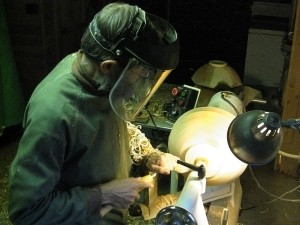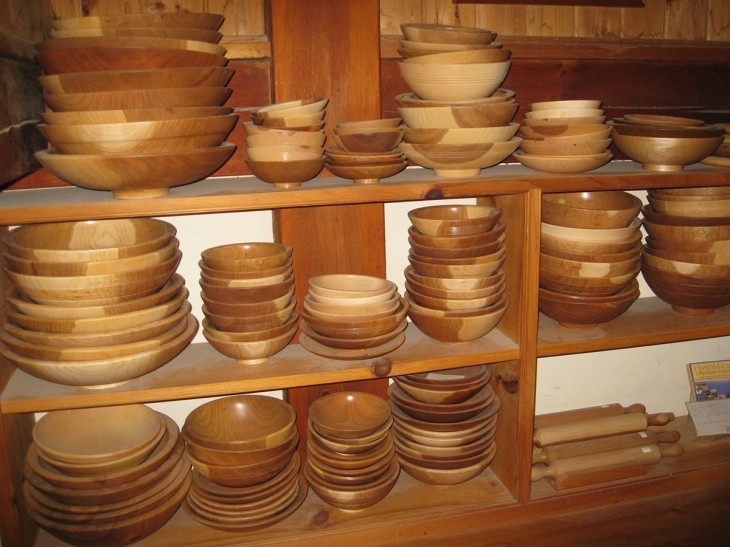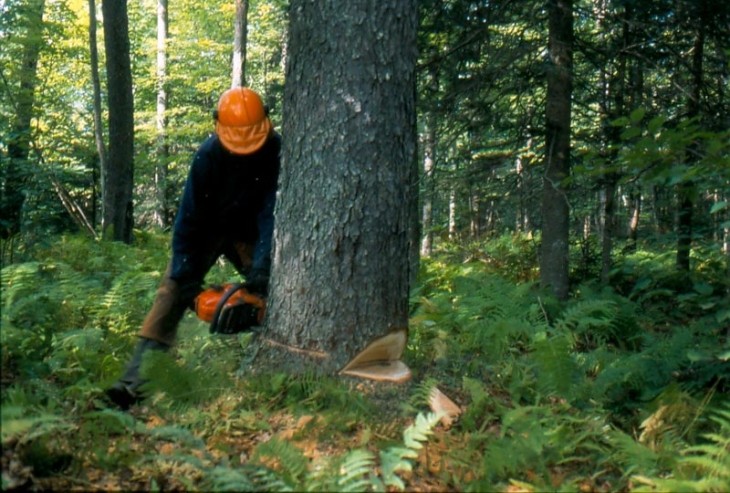Dave Brown moved to Craftsbury, Vermont, in 1974 to take a teaching job at what is now Sterling College. He’d grown up near Salt Lake City, Utah, and in Texas, gone to college in Wisconsin, and was drawn to Vermont – like so many others – by its pastoral landscape. In the years since, Dave has taken epic canoe trips and winter treks in the wilder places north of Vermont (often with Northern Woodlands contributors Robert Kimber and Jerry Jenkins) and has documented these in self-published books. He ran the Wildbranch Writing Workshop at Sterling for more than two decades. He and his wife, Ann Ingerson, play music (Dave the banjo, Ann the fiddle), bake bread in an outdoor oven they built, tend a large garden and a small orchard, press cider and brew beer. Around 1990, Dave turned his attention to wood turning, and he’s found a specialty in crafting bowls from a variety of wood species.
My dad was a physician, and all the way through high school and college, I’d planned on going into medicine. But my last year of college, I kind of had an epiphany and realized I enjoyed the outdoor stuff too much to spend a good chunk of my life in clinics or hospitals. So I sort of backed away from that. And I have no regrets.
I came to Craftsbury one year out of college. I was teaching a lot of outdoors skills. Everything from using axes, crosscuts, and chainsaws to tree identification, first aid, map and compass, photography, winter camping and whitewater canoeing. Although, truth be told, I was learning a lot of that stuff five minutes ahead of teaching it to the students. I’d had very little experience with those things when I first got here. I was expected to be one of the tree ID experts, and at that point, I was doing well to tell a maple tree from a pine. So I did some scrambling in the early days.
When I moved here, I barely knew which end of a hammer to hold. Soon after I arrived in Craftsbury, I met Horace Strong, who taught shop at the high school and was a canoe builder, and we got to be really good friends. He introduced me to the idea that when you break an axe handle, you don’t go to a hardware store and buy one – you make another one.
I loved the idea of making useful things out of wood, so that’s something that we incorporated into the Sterling curriculum. The students all made their own canoe paddles for many years and about half the students made their own snowshoes. I taught at Sterling full-time from 1974 until about 1995. Then I kind of phased out gradually as I shifted into doing woodworking.
When I started off, for some reason I decided I wanted to make Shaker rocking chairs. That’s the first turning I did, using the lathe to turn the legs and spindles of the rocking chairs. I discovered pretty quickly that it’s one thing to make nice furniture, but another thing to be able to sell it consistently. I think at one point I had 12 rocking chairs sitting around. Then I started making a few wooden bowls, and I’d bring those along with me to craft shows. And there seemed to be more interest in the bowls than there was in the furniture.
All along, I’ve just enjoyed making things. I made landing nets for fishing for many years and sold those. I’ve made toboggans, which we use for hauling gear on our winter trips. My interest now is in making functional bowls and plates – things that people will use daily for eating.
In terms of turning, probably my favorite wood is cherry, and that’s partly because it’s the most popular wood. I love turning ash and birch and all those other woods, but the fact of the matter is I’ll sell 10 cherry bowls for every ash bowl. Cherry is nice to work with. It’s relatively easy to come by around here. It smells good, finishes well.
I cut maybe half of the logs I use for bowls either on our own land or on neighbors’ land. I’ll keep my eyes out for trees. There’s a blight that’s killing butternut trees, and on one of my bike rides, I noticed a very nice butternut tree with a mostly dead crown. I approached the landowner about harvesting the tree. He was agreeable so I cut the tree and paid him a good price.
A while back, we took down a cherry tree right out the back door. It was big enough that it was going to be problematic for the power line and potentially the house. A friend came over with his climbing ropes and his chainsaw and took it down. I got half a cord of firewood and 75 bowls from that tree.
We’ve cut all our own firewood for 40 years. We heat the whole house and shop with under three cords of wood. I enjoy working in the woods. I cut it and I split it by hand. We have a woodshed up in the woods where it seasons for a year. We split it there. We borrow a friend’s truck, and when the road opens up in the spring, we’ll spend a day and move all that wood down to the basement. We have a wooden plank that we run through the window there to make a chute. One of us unloads the truck and sends the wood down the chute, and the other one’s down here stacking. Usually within a day we can move in a year’s worth of firewood.
Oftentimes if I cut a tree and the bottom log is nice wood, I’ll keep some of that and turn it into bowls instead of firewood. The diameter of the bowl you get is determined by the diameter of the tree. I’m usually looking for a sizeable tree with a minimum number of defects such as cracks, rot, or knots, though I can work with a crooked log and to some extent work around knots. It doesn’t make sense to take a veneer-grade tree and cut it up into short pieces for bowls.
Everybody thinks a bowl is a bowl, but there are so many variations in terms of the foot and the rim and the ornamentation, and obviously the grain is different from bowl to bowl. There is a symmetry in the grain pattern that doesn’t happen by accident. I’ll begin turning the initial block of wood, see how the grain looks and then tweak it a little bit one way or the other to get the symmetry.
I do all the initial turning when the wood is freshly cut, it’s still green. The walls of the rough bowl are still fairly thick. This bowl will dry for many months. Since the wood shrinks more across the grain than along the grain, the bowl distorts. It has to go through that drying process very slowly, otherwise it will crack – and then you’ve got expensive firewood. Once completely dry, the bowl is remounted on the lathe, turned true, and then finished.
For many years I kept track of weather events, when I first saw a certain bird species, when we got the first snow and when the ice melted and when the ice froze over. I’d basically record all our fishing and hunting trips – where and when and what we got. That’s a neat record to have, but it’s also pretty sad to go back and read the way it was 30 and 40 years ago.
I used to do a lot of bird hunting around here for grouse and woodcock, but bird numbers have just declined drastically, to the point where I don’t really do much hunting here anymore. There aren’t a lot of birds, number one, and the places where I used to hunt are no longer in an appropriate stage of habitat or the land is posted or has houses built on it.
One of the most obvious changes is we’re starting to see more and more oak up here in our woods. Thirty or forty years ago there were a few ornamental oaks around, but you wouldn’t find oaks back in your woods. Now we are finding oak in our woods. That’s an indicator that climate is moderating. The insect pests seem to be proliferating. In the garden, there are new pests every year. In the woods, too, there are new infestations of creatures that are eating the foliage.
Last summer was my 50th summer of canoe tripping. It started when I was college, in Wisconsin, and I first ran across the writing of Sigurd Olsen and read about the Boundary Waters Canoe Area. I talked my family into driving up from Houston, picking me up in Wisconsin, and we continued up to Ely, Minnesota. We rented two Grumman canoes, went out for a week-long canoe trip, and I fell in love with it all – the country and the travel and the idea that you could paddle around in a canoe every day and carry all your gear.
After that, I started doing canoe trips with friends – initially trips that were relatively simple, close-by, and short. As we developed more skills, we started doing longer and more remote trips. Now, as we’re getting into the geriatric phase, we’re not doing trips that are quite as arduous and remote as they were.
In some ways probably the most spectacular one was a trip where we paddled 350 miles up the northern coast of Labrador, into the Torngat Mountains. We started in Nain and paddled up the coast, came up through Nachvak Fjord, and then spent a week portaging and paddling up the Palmer River, across the height of land, and down the Koroc River to Ungava Bay. That was a six-week trip. Just spectacular country. The Torngats are the highest mountains in eastern North America. There’s a lifetime of canoeing in Quebec and Labrador – convenient for paddlers living in the Northeast. It’s very, very lightly traveled country. It’s very unusual to see anybody on those trips.













Discussion *